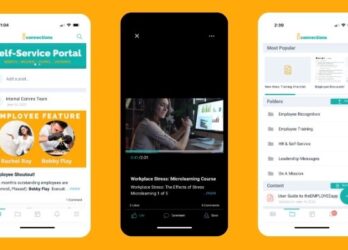Last updated on March 7, 2024 at 10:34 am
As businesses continue to navigate the ever-changing landscape of the modern workplace, one aspect remains constant: the importance of training and development for employees. While this has always been a crucial element in any company’s success, it has become even more essential in recent times. The rise of technology and its impact on various industries have led to a heightened demand for skilled workers who can keep up with evolving processes and tools. In this fast-paced environment, frontline employees play a vital role as they are often the face of the organization to customers and clients.
Thus, companies must provide them with comprehensive training and development opportunities that align with their roles and responsibilities. This blog post will explore how organizations can leverage intranet resources to train and develop their frontline employees – ultimately leading to improved performance, engagement, and retention.
The Training Challenge for Frontline Employees
Frontline and deskless employees commonly encounter the following hurdles in their learning and development endeavors:
Limited Access to Traditional Training Methods
Frontline workers often operate on irregular schedules, creating logistical challenges for scheduling in-person training sessions. The inability to align the location of workers with trainers or managers makes it difficult to ensure consistent participation in essential training. Consequently, employees may miss out on critical learning opportunities, impacting their job performance and overall effectiveness. The constraints of traditional training methods in accommodating diverse work schedules further exacerbate the challenge, emphasizing the need for flexible and accessible training alternatives.
Inefficient and Outdated Training Formats
Employees frequently encounter a lack of relevant learning experiences due to outdated training content and ineffective delivery methods. The failure to update training materials can lead to a disconnect between employee knowledge and the evolving demands of their roles. This mismatch can impede productivity and hinder employees from reaching their full potential. Moreover, the reliance on obsolete training formats may result in employees becoming disengaged or skeptical about the value of the provided training, emphasizing the critical need for organizations to reassess and modernize their training approaches.
Difficulty in Measuring Effectiveness and ROI
Evaluating the impact of training on participants’ performance poses a significant challenge, particularly when assessing intangible factors such as teamwork and morale. The inherent difficulty in quantifying these elements introduces ambiguity into the evaluation process, hindering the ability to determine the true effectiveness of training initiatives. This lack of clarity can impede decision-making processes related to resource allocation for future training programs. The complexity of measuring return on investment (ROI) underscores the need for organizations to develop more nuanced and comprehensive evaluation methodologies that go beyond quantitative metrics.
Lack of Engagement and Motivation
Frontline workers, often operating outside the physical office, may experience a sense of detachment from the organizational culture. This disconnection can lead to a lack of motivation among employees to participate in training initiatives actively. The absence of a clear understanding of the value of training further contributes to low engagement levels, potentially resulting in incomplete or superficial participation. Organizations must grapple with the challenge of maintaining employee motivation in remote or decentralized work settings, acknowledging the impact it can have on the overall success of training programs.
The Power of the Intranet for Training and Development
In the dynamic landscape of frontline work, addressing the unique challenges of geographically dispersed employees is crucial. Leveraging an intranet proves instrumental in overcoming these challenges, fostering accessibility and convenience in frontline training initiatives.
Accessibility and Convenience:
Frontline workers, scattered across locations, benefit from the flexibility afforded by an intranet, offering easy access to training resources. This accessibility not only enhances employee performance but also cultivates engagement in their day-to-day roles.
Variety of Engaging and Interactive Content:
In the face of understaffing-induced stress in the frontline workforce, intranets play a pivotal role in promoting well-being through gamification. By incorporating elements like peer-to-peer recognition, badges, and leaderboards, the intranet not only introduces an element of fun to the learning process but also fosters healthy competition and sustained interest among employees.
Personalized Learning Paths:
The implementation of personalized learning on the intranet enriches the overall learning experience, empowering learners to navigate content tailored to their personal and professional objectives. Studies, such as those by the Association for Talent Development (ATD), underscore the effectiveness of personalized training in enhancing job performance, emphasizing the accelerated learning and expertise gained through this targeted approach.
Social Learning and Collaboration:
The intranet’s intuitive and interactive platform transforms traditional training approaches by creating a peer-to-peer learning atmosphere. This facilitates the sharing of ideas, industry discussions, knowledge expansion, and collaborative problem-solving, enhancing engagement compared to conventional training tools.
Performance Tracking and Analytics:
Linking employee training with performance, the intranet provides managers with tangible metrics for informed decision-making. This integration allows for a comprehensive understanding of employee performance, enabling targeted interventions to address improvement areas and drive frontline success.
Cost-Effective and Scalable:
Cloud-based intranets offer superior scalability compared to traditional training solutions. The agility to swiftly modify and update resource allocation aligns with changing business needs, providing a cost-effective and scalable approach to training implementation.
Practical Strategies for Leveraging Intranet Resources
Content Development and Curation
For frontline workers, having 24/7 access to a desktop computer is not possible. Hence, organizations must ensure their intranet is easily accessible via mobile phones. A mobile responsive web app is the baseline for your frontline teams engaging with your intranet.
Additionally, offer employees training paths based on their role, industry, and needed business skills.
Allow employees to gain professional skills they can use in the workplace.
Utilize multimedia elements like images, audio, videos, infographics, and quizzes.
Personalization and Recommendations
A one-size-fits-all approach will not benefit anyone. Understand each employee’s personal and professional goals and job requirements. Then, customize the content accordingly.
Implement microlearning to create a culture of continuous learning.
Facilitate constant progress monitoring to keep frontline workers on the right learning and improvement track.
AI can recommend personalized resources for further upskilling.
Engagement and Gamification
- Enable learners to progress through levels with each training milestone, fostering a sense of achievement and continuous advancement.
- Recognize and reward their accomplishments by issuing badges upon successful project completion or the attainment of specific milestones.
- Showcase their achievements prominently on a leaderboard, providing a public platform for everyone to acknowledge and celebrate their significant wins.
- The visibility of personal growth and the provision of swift feedback serve as catalysts for improved performance and sustained motivation.
- Cultivate a collaborative atmosphere through systems where peers can actively cheer for each other, transforming the work environment into a collective team effort with shared goals and achievements.
Tracking and Measurement
- Implement robust tools within your intranet-based training system to efficiently monitor and generate comprehensive reports. This ensures a vigilant oversight of your frontline workers’ performance, allowing for timely interventions and enhancements.
- Monitor the completion status of courses, quiz scores, and overall user activity to gather valuable insights into the effectiveness of the training program.
- Leverage these insights as cues to pinpoint areas that may require additional support or resources, facilitating a proactive approach to addressing potential challenges.
- Incorporate regular feedback surveys and knowledge retention checks into the training program, creating a continuous feedback loop.
Summing Up
The effective implementation of training and development programs through the utilization of intranet resources has proven to be a pivotal strategy for empowering frontline employees. By harnessing the power of digital platforms within the organizational framework, companies can not only enhance the skills and knowledge of their frontline workforce but also foster a culture of continuous learning and adaptability.
Frequently Asked Questions
Q: How much does on-the-job training help improve the performance and involvement of frontline workers?
On-the-job training is a great way to train frontline workers because it gives them direct experience and lets them use their new skills in real life. It can also improve employee involvement, job satisfaction, and performance while cutting down attrition rates and training costs.
Q: How can a robust training and development program affect a business’s bottom line?
Performance leads to productivity. Training helps employees reach their full potential. Employees equipped with requisite knowledge and skills can perform better at their work and, thus, drive business growth.
Q: What are the benefits of using an intranet for training and development programs for frontline workers?
The following are the key benefits of using an intranet for training and development programs for frontline workers:
- Easy accessibility
- Improved engagement
- Personalized learning experience
- Improved internal communication
- Quick feedback
Subscribe To The theEMPLOYEEapp Newsletter
Comments are closed.




